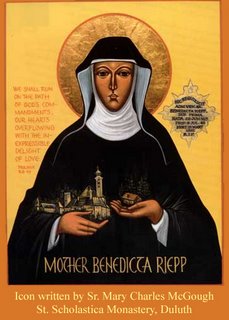Our fledgling blogger, Sister Edith OSB of St Scholastica in Duluth, who blogs at Monastic Musings, has an interesting shorter version as to how the Benedictine nuns of Minnesota came to be here:
A Woman of Courage, Mother Benedicta Riepp
. Imagine this scene: someone must be selected to head a very small group of people sent to a distant country. They can take only a little money and very little luggage. Once there, they have to find a way to support themselves while learning a new language, dealing with a strange culture, and carrying out an important mission.
Imagine this scene: someone must be selected to head a very small group of people sent to a distant country. They can take only a little money and very little luggage. Once there, they have to find a way to support themselves while learning a new language, dealing with a strange culture, and carrying out an important mission.
What kind of person would you select? This was the problem that faced the superior at the Abbey of St. Walburga in Eichstatt, Germany in 1852.
 Imagine this scene: someone must be selected to head a very small group of people sent to a distant country. They can take only a little money and very little luggage. Once there, they have to find a way to support themselves while learning a new language, dealing with a strange culture, and carrying out an important mission.
Imagine this scene: someone must be selected to head a very small group of people sent to a distant country. They can take only a little money and very little luggage. Once there, they have to find a way to support themselves while learning a new language, dealing with a strange culture, and carrying out an important mission.What kind of person would you select? This was the problem that faced the superior at the Abbey of St. Walburga in Eichstatt, Germany in 1852.
The usual choice would be: someone who is an experienced administrator, or a world traveler, or familiar with different languages. But there were no such sisters at the Abbey.
In fact, there were very few sisters with any length of experience of religious life. The Abbey had been supressed in the secularization of Germany, in 1806. They had been prevented from accepting any new members for nearly 30 years. Only 13 eldery sisters survived to pass along the Benedictine heritage and way of life in 1835 when the cloister doors were re-opened -- so long as the sisters would also open a school.
So, when Abbot Boniface Wimmer asked that sisters be sent to America, to staff schools for German immigrants, he was asking the Abbey to make the sacrifice of sending some of the new and younger sisters, not yet very seasoned in the monastic way of life, on this unknown venture.
Mother Benedicta Riepp was 26 years old when she was chosen, and had only been a professed sister for a few years. She made up for her lack of experience in administration or world travel with deep faith, a generous heart, and an ability to adapt to difficult circumstances.
Life in America was hard: no one met the sisters, their original location in the "wilds of Pennsylvania" was isolated, they had little money, and they suffered from cold and hunger. No provision had been made for the keeping of cloister, and they were forced to adapt many of the requirements of monastic life. Nonetheless, from their first year in America, people sought to join them in their lives of work and prayer.
The members of the 46 monasteries who trace their roots to Mother Benedicta Riepp and her two companions, Sister Walburga Dietrich and Sister Maura Flieger celebrate July 22 as Founders' Day, remembering these three women as well as those who carried on their courage to start new monasteries.
 In Duluth, we remember Mother Scholastica Kerst (with umbrella). The first attempt to open a school in Duluth had been, quite literally, frozen out of existence by snow and ice blowing through the cracks in the board walls of the building. In 1892, a group of 32 we finally able to make a foundation. Mother Kerst searched everywhere to find land that would be high - a characteristic of Benedictine monasteries - overlooking Lake Superior. She settled on our current site, 160 acres known as the Daisy Farm, in honor of the only crop that grows in shallow soil and a harsh climate.
In Duluth, we remember Mother Scholastica Kerst (with umbrella). The first attempt to open a school in Duluth had been, quite literally, frozen out of existence by snow and ice blowing through the cracks in the board walls of the building. In 1892, a group of 32 we finally able to make a foundation. Mother Kerst searched everywhere to find land that would be high - a characteristic of Benedictine monasteries - overlooking Lake Superior. She settled on our current site, 160 acres known as the Daisy Farm, in honor of the only crop that grows in shallow soil and a harsh climate.Today, it is hard to imagine entrusting that much responsibility to a 27-year old without extensive training and preparation. Harder still to imagine the difficulty of making choices in unforeseen circumstances, of trying to provide training in religious life to the dozens of people who sought to join the comunity within a few years, or of adapting to the American way of life. [snip] Read More
No comments:
Post a Comment